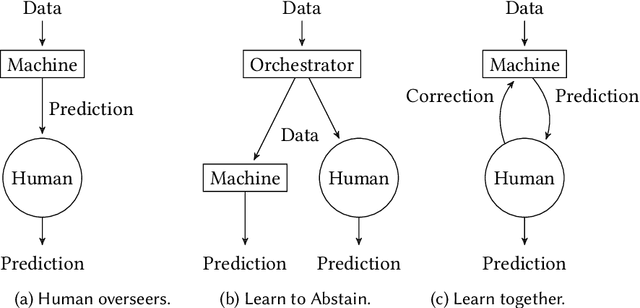Roberto Pellungrini
Interpretable and Fair Mechanisms for Abstaining Classifiers
Mar 24, 2025Abstract:Abstaining classifiers have the option to refrain from providing a prediction for instances that are difficult to classify. The abstention mechanism is designed to trade off the classifier's performance on the accepted data while ensuring a minimum number of predictions. In this setting, often fairness concerns arise when the abstention mechanism solely reduces errors for the majority groups of the data, resulting in increased performance differences across demographic groups. While there exist a bunch of methods that aim to reduce discrimination when abstaining, there is no mechanism that can do so in an explainable way. In this paper, we fill this gap by introducing Interpretable and Fair Abstaining Classifier IFAC, an algorithm that can reject predictions both based on their uncertainty and their unfairness. By rejecting possibly unfair predictions, our method reduces error and positive decision rate differences across demographic groups of the non-rejected data. Since the unfairness-based rejections are based on an interpretable-by-design method, i.e., rule-based fairness checks and situation testing, we create a transparent process that can empower human decision-makers to review the unfair predictions and make more just decisions for them. This explainable aspect is especially important in light of recent AI regulations, mandating that any high-risk decision task should be overseen by human experts to reduce discrimination risks.
Deferring Concept Bottleneck Models: Learning to Defer Interventions to Inaccurate Experts
Mar 20, 2025Abstract:Concept Bottleneck Models (CBMs) are machine learning models that improve interpretability by grounding their predictions on human-understandable concepts, allowing for targeted interventions in their decision-making process. However, when intervened on, CBMs assume the availability of humans that can identify the need to intervene and always provide correct interventions. Both assumptions are unrealistic and impractical, considering labor costs and human error-proneness. In contrast, Learning to Defer (L2D) extends supervised learning by allowing machine learning models to identify cases where a human is more likely to be correct than the model, thus leading to deferring systems with improved performance. In this work, we gain inspiration from L2D and propose Deferring CBMs (DCBMs), a novel framework that allows CBMs to learn when an intervention is needed. To this end, we model DCBMs as a composition of deferring systems and derive a consistent L2D loss to train them. Moreover, by relying on a CBM architecture, DCBMs can explain why defer occurs on the final task. Our results show that DCBMs achieve high predictive performance and interpretability at the cost of deferring more to humans.
One-Shot Clustering for Federated Learning
Mar 06, 2025Abstract:Federated Learning (FL) is a widespread and well adopted paradigm of decentralized learning that allows training one model from multiple sources without the need to directly transfer data between participating clients. Since its inception in 2015, it has been divided into numerous sub-fields that deal with application-specific issues, be it data heterogeneity or resource allocation. One such sub-field, Clustered Federated Learning (CFL), is dealing with the problem of clustering the population of clients into separate cohorts to deliver personalized models. Although few remarkable works have been published in this domain, the problem is still largely unexplored, as its basic assumption and settings are slightly different from standard FL. In this work, we present One-Shot Clustered Federated Learning (OCFL), a clustering-agnostic algorithm that can automatically detect the earliest suitable moment for clustering. Our algorithm is based on the computation of cosine similarity between gradients of the clients and a temperature measure that detects when the federated model starts to converge. We empirically evaluate our methodology by testing various one-shot clustering algorithms for over thirty different tasks on three benchmark datasets. Our experiments showcase the good performance of our approach when used to perform CFL in an automated manner without the need to adjust hyperparameters.
Mathematical Foundation of Interpretable Equivariant Surrogate Models
Mar 03, 2025Abstract:This paper introduces a rigorous mathematical framework for neural network explainability, and more broadly for the explainability of equivariant operators called Group Equivariant Operators (GEOs) based on Group Equivariant Non-Expansive Operators (GENEOs) transformations. The central concept involves quantifying the distance between GEOs by measuring the non-commutativity of specific diagrams. Additionally, the paper proposes a definition of interpretability of GEOs according to a complexity measure that can be defined according to each user preferences. Moreover, we explore the formal properties of this framework and show how it can be applied in classical machine learning scenarios, like image classification with convolutional neural networks.
Bridging the Gap in Hybrid Decision-Making Systems
Sep 28, 2024Abstract:We introduce BRIDGET, a novel human-in-the-loop system for hybrid decision-making, aiding the user to label records from an un-labeled dataset, attempting to ``bridge the gap'' between the two most popular Hybrid Decision-Making paradigms: those featuring the human in a leading position, and the other with a machine making most of the decisions. BRIDGET understands when either a machine or a human user should be in charge, dynamically switching between two statuses. In the different statuses, BRIDGET still fosters the human-AI interaction, either having a machine learning model assuming skeptical stances towards the user and offering them suggestions, or towards itself and calling the user back. We believe our proposal lays the groundwork for future synergistic systems involving a human and a machine decision-makers.
AI, Meet Human: Learning Paradigms for Hybrid Decision Making Systems
Feb 09, 2024



Abstract:Everyday we increasingly rely on machine learning models to automate and support high-stake tasks and decisions. This growing presence means that humans are now constantly interacting with machine learning-based systems, training and using models everyday. Several different techniques in computer science literature account for the human interaction with machine learning systems, but their classification is sparse and the goals varied. This survey proposes a taxonomy of Hybrid Decision Making Systems, providing both a conceptual and technical framework for understanding how current computer science literature models interaction between humans and machines.
 Add to Chrome
Add to Chrome Add to Firefox
Add to Firefox Add to Edge
Add to Edge